
| Abiqua Dogs |
| Abiqua Pumi |
| About Pumis |
| Our Dogs |
| Our Home |
| Grooming |
| Pumi Standard |
| Getting a Puppy |
| Puppies |
| Links |
DESCRIPTION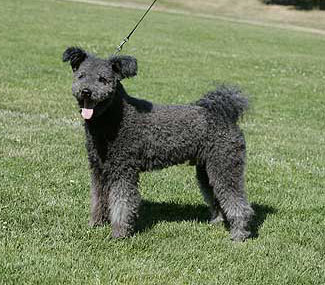
A Pumi is a square-looking, active dog, light-bodied and racey, who looks heavier than he is due to a longish, curly coat. Pumis come in every color between white and black, with gray shades being the most common. The most notable part of this breed is the hairy, upright ears with tips folded over, which are constantly moving, since nothing escapes their attention. The coat needs to be combed every 2 -3 weeks, with occasional trimming. Hair will come out when combing, but typically they don't shed. Pumis have the intelligence and biddability of a herding dog and the alertness of a terrier.
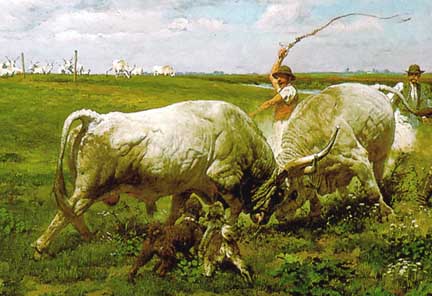
HISTORY
The Pumi shares a common history with the Puli, both are Hungarian herding dogs and considered the same breed until the turn of the twentieth century. It is thought that the Pumi type came from the interbreeding of the Pulis with a French or German type of terrier which gave it the square outline, narrower head, and livelier attitude. The Pumi has been considered a separate breed since 1920. They are used for herding sheep and cattle. There are approximately 3000 Pumis in Hungary, about 1000 in Finland, a few in other European countries, and a few dozen in the USA.
COLORS
The Pumi comes in many solid colors. They can be any shade of gray, black, white, and fawn. The gray puppies are born black and fade to some shade of gray. In addition, they may have lighter gray shadings on the head and legs. They fawns (the Hungarian term is "fako") are usually born dark brown/black and fade to some shade of fawn, even appearing to be a creamy white. The whites are born white and stay that way. Occasionally a black and tan patterned puppy is born (like a black and tan Doberman). This is not an allowed color in the standard.
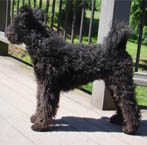 |
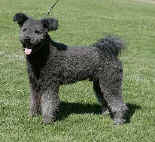 |
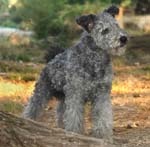 |
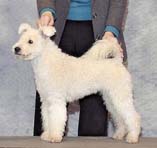 |
 |
Black |
Dark Gray |
Silver Gray |
Fawn |
White |
TEMPERAMENT
 The temperment of the Pumi is a traditional herding
dog's, easily taught, but with a little terrier thrown in so that they
are interested in everything that's going on. The Pumi tends to be wary of strangers, so it's important when they're young to expose them to lots of new situations, so that they will deal with unusual situations and strangers as a confident adult. The individual Pumi can be a lapdog, or may be content just to lay at your feet, but they do want to be near you. Pumis basically get
along well with other Pumis and housepets.
The temperment of the Pumi is a traditional herding
dog's, easily taught, but with a little terrier thrown in so that they
are interested in everything that's going on. The Pumi tends to be wary of strangers, so it's important when they're young to expose them to lots of new situations, so that they will deal with unusual situations and strangers as a confident adult. The individual Pumi can be a lapdog, or may be content just to lay at your feet, but they do want to be near you. Pumis basically get
along well with other Pumis and housepets.
A Pumi needs to use its mind and if not given tasks to do, will invent them, usually to the chagrin of its family. It is a good size for a lap dog, and likes to be petted, but may not stay for long if something else is going on. It also likes to be in high places, all the better to check out what's going on. The Pumi wants to be where the action is, or as close to the center of happenings as possible. A sufficiently eventful daily life, free of long hours of boredom alone, is enough for most Pumis. Tennis balls and frizbees are especially important toys and they may be rather demanding about having them thrown.
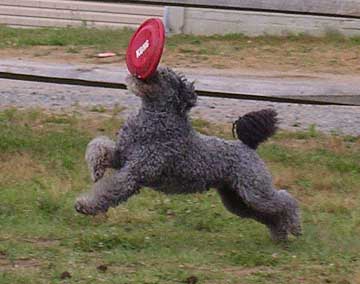
ACTIVITIES WITH YOUR PUMI
If you want more than a family pet, the Pumi is extremely good at obedience, agility, and flyball. There are several Pumi obedience champions and world champions in agility in European countries. The Pumi has the energy and the physical capacities to jump obstacles, climb over planks, and zigzag between posts. Pumis have also done well in tracking. One dog in Europe has been trained for security and guarding. Most Pumis do well in herding and almost all who have been tested have passed herding instinct tests.
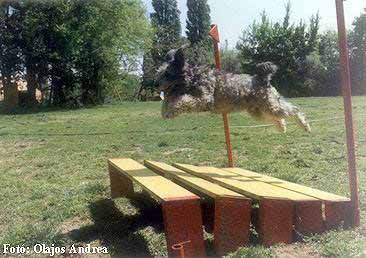
BARKING
The Pumi is a herding and/or watch dog, and uses it's
bark to help with its herding. It's
in its nature to give alarm when someone knocks on your door or
something comes close to its house. It's important to clearly tell your Pumi where the
boundary lays and what is permitted. Training must be consistent
and firm. The Pumi is smart enough to see through its
owners weaknesses, and if you have a tendency to be compliant the Pumi
will immediately find the loopholes.
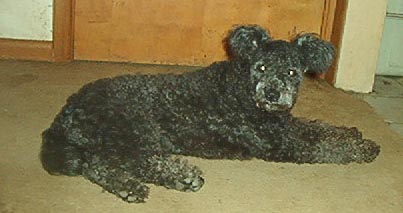
If you are looking for a stylish comrade who leisurely stretches out quietly on the sofa all day, and who is never bothersome, then the Pumi is not for you, but if you want a best buddy who loves to be as active as you are, a Pumi may be just the right fit.
DETAILS
Size: males 16" - 18", females 15" - 17"
Weight: males 22 - 33 lb., females 18 - 26 lb.
Copyright © 2000 All Rights Reserved
Last updated: 12/20/17